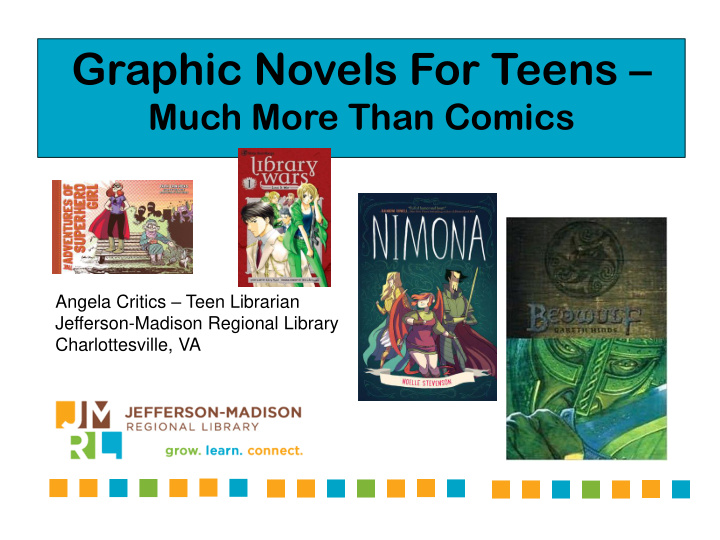



Graphic Novels For Teens – Much More Than Comics Angela Critics – Teen Librarian Jefferson-Madison Regional Library Charlottesville, VA
Love ‘ em or Hate ‘ em You can’t avoid them
Wha hat is t is a Gr Graphic No phic Novel? el? It’s a format – Not a genre
A graphic novel is a book written and illustrated in the style of a comic book with sequential art. Types of graphic novels: Comic book Adaptation of a classic Adaptation of a popular book Original work – either stand alone or series Manga
“But they’re not real books” Actually, they are! Even if they weren’t – so what? Gateway for reluctant readers Moving into the classroom as teaching tools
Benefits for reluctant & emergent readers: Aids visualization of story Immersive experience heightens enjoyment Images help decode complex concepts and vocabulary
In the classroom: As complex as any novel Used to teach visual rhetoric Can make complex literary concepts more accessible Studies show increased retention with graphic novel format for textbooks Builds verbal-visual literacy
Graphic novels strengthen skills in: Attention & attention to detail Memory Sequencing Language and language usage
Mang Manga vs. Anime a vs. Anime What’s the difference? Manga = Print Anime = Video
Thing hings s to to kn know w abo bout ut man manga ga: It’s a format, not a genre Stylistic conventions Exaggerated depictions Reads right to left Popular but not sturdy Replacements hard to find Series can be very long!
Other Manga Other Manga Ter erms: ms: Target audience categories: Shonen (Boys 10-18) Shojo (Girls 10-18) Josei (College-age women) Seinen (College-age men) General terms: Fan service Omake (extras) Manhua Manhwa
Thank Y hank You! ou! Presented by: Angela Critics Young Adult Librarian JMRL -Central Library Charlottesville, VA acritics@jmrl.org
Recommend
More recommend